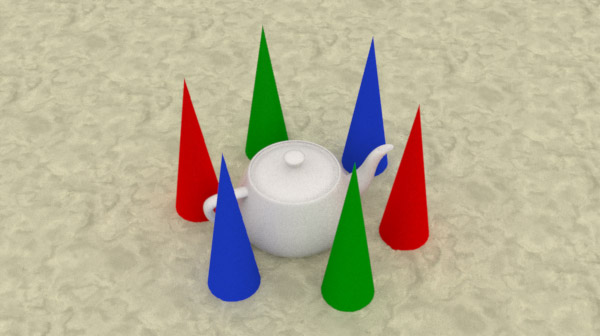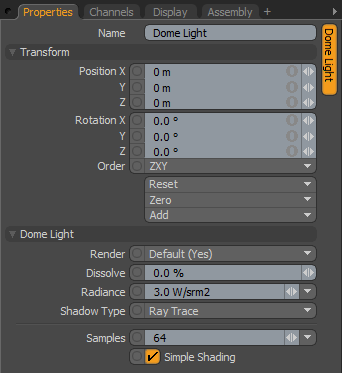
The Dome light creates a virtual dome of lights around the scene producing a flat, even illumination over surfaces similar to photos taken on an overcast day. Dome lights have often been used to simulate Global Illumination; however, with the modo rendering engine, Global Illumination is just as fast, if not faster than dome lights and generally yields more pleasing results. This light has Position and Rotation controls as well as Radiance, Shadow Type and Samples. Note that there is no size or scale value as the dome will always scale itself to encompass the entire scene, regardless of size. To control the lights color, shadow color and other material related properties, refer to the Light Material page of the documentation.
Dome Light
 Name: This data field displays the current item name. Users may easily change it by LMB-clicking within the field and typing the new name.
Name: This data field displays the current item name. Users may easily change it by LMB-clicking within the field and typing the new name.
Transform--
Position: An Item transform that allows the user to numerically position the light item in XYZ space. By default, Position transforms originates from the items center position.
Rotation: An Item transform that allows the user to numerically set the rotation of the light item. By default, Rotation transforms originates from items center position.
Order: Allows the user to set the order that rotations are applied to the light item. Changing the order that rotations are applied can sometimes help to reduce or eliminate gimbal lock.
Reset: Resets the selected transform values to (0,0,0) returning the items back to the world space center position.
Zero: Returns the light items Center position to the world space center (0,0,0) without changing the position of the light item itself.
Add: The 'Add' function will add the selected set of transforms to the channel list. Useful when animating complex motions, providing a layered approach to the transforms.
Dome Light--
Render: This drop down menu allows the user to select from 3 choices, when set to 'Default', the user can enable/disable lights using the visibility function "![]() " of the item list. When the light is visible, it contributes to the final rendered scene and when invisible, it will not. On some instances the user may prefer to fix this state, setting the light as 'On' (enabled) or 'Off' (disabled) regardless of visibility. Also useful for workflows that auto toggle visibility, saving the user from manually enabling lights for test renders.
" of the item list. When the light is visible, it contributes to the final rendered scene and when invisible, it will not. On some instances the user may prefer to fix this state, setting the light as 'On' (enabled) or 'Off' (disabled) regardless of visibility. Also useful for workflows that auto toggle visibility, saving the user from manually enabling lights for test renders.
Dissolve: When the 'Dissolve' function is set to any value above 0%, the lights overall affect on the scene will attenuate as the value increases. When set to 100%, the lights effect on the scene is completely disabled. This function providing a convenient way to dim a lights effect within a scene.
Radiance: This value controls the intensity of the light and uses the standard physically based unit of Watts per volumetric meter. As you would expect, increasing this value will increase the apparent brightness of the Dome Light and decreasing the value reduces the lights intensity. Since the area that produces the light is so large, small values are all that are necessary to illuminate a scene properly.
Shadow Type: This popup offers options between 'Ray Traced' , 'None' and 'Deep Shadow Maps'. In situations where users want a light to cast a shadow, Ray Traced will give the most accurate results. Deep Shadow maps are useful for fur rendering, where a great deal of calculations are required to produce shadows; producing similar results to ray traced shadows while reducing the number of calculations.
Samples: A Dome light illuminates a scene in a way similar to sampling lights from multiple positions across the dome and blending them for the final result. The 'Samples' setting defines how many samples are taken. Low sample values often produce shading that appears too grainy, increasing this value will reduce or eliminate the grain at the expense of longer render times.
Simple Shading: With the 'Simple Shading' checkbox enabled, modo will calculate the specular and diffuse values for a surface as if the dome light were a single point. However, with 'Simple Shading' disabled, modo uses the same light array as the shadows to calculate the specular and diffuse values. This results in diffuse and specular shading that is 'soft', matching the shadows, but can also become increasingly grainy with a lower number of samples. Increasing the number of 'Samples' will reduce grain in the diffuse and specular shading as well as the shadows at the expense of longer render times.


